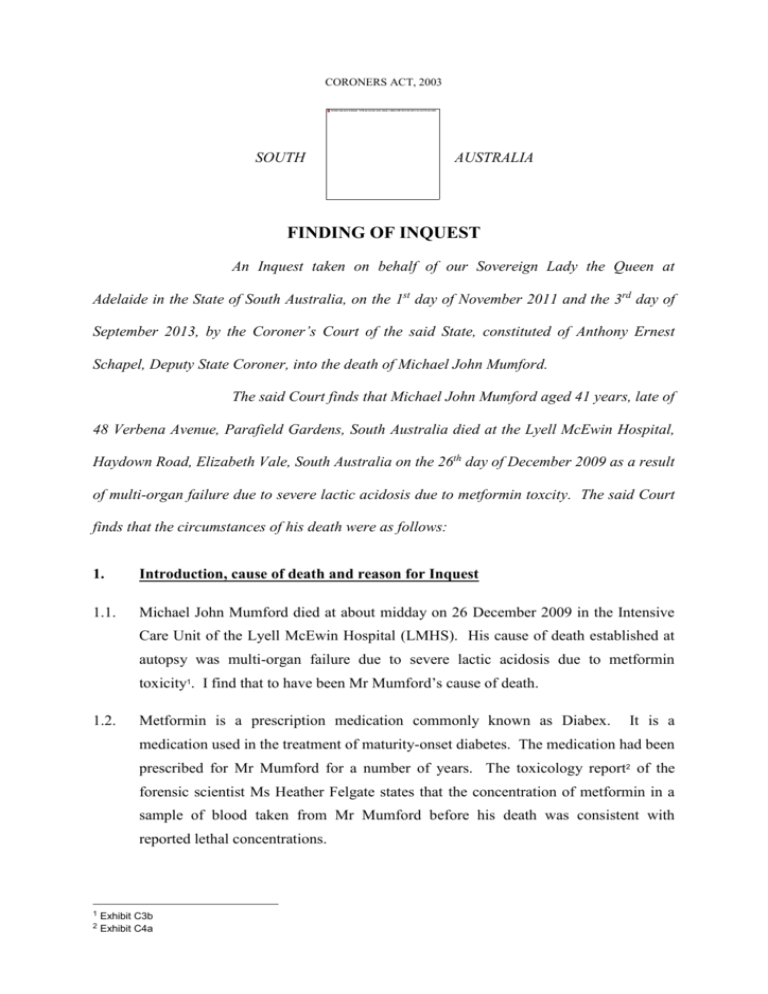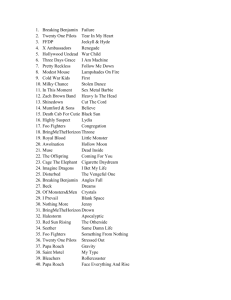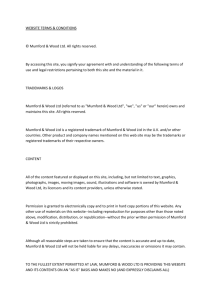MUMFORD Michael John
advertisement

CORONERS ACT, 2003 SOUTH AUSTRALIA FINDING OF INQUEST An Inquest taken on behalf of our Sovereign Lady the Queen at Adelaide in the State of South Australia, on the 1st day of November 2011 and the 3rd day of September 2013, by the Coroner’s Court of the said State, constituted of Anthony Ernest Schapel, Deputy State Coroner, into the death of Michael John Mumford. The said Court finds that Michael John Mumford aged 41 years, late of 48 Verbena Avenue, Parafield Gardens, South Australia died at the Lyell McEwin Hospital, Haydown Road, Elizabeth Vale, South Australia on the 26th day of December 2009 as a result of multi-organ failure due to severe lactic acidosis due to metformin toxcity. The said Court finds that the circumstances of his death were as follows: 1. Introduction, cause of death and reason for Inquest 1.1. Michael John Mumford died at about midday on 26 December 2009 in the Intensive Care Unit of the Lyell McEwin Hospital (LMHS). His cause of death established at autopsy was multi-organ failure due to severe lactic acidosis due to metformin toxicity1. I find that to have been Mr Mumford’s cause of death. 1.2. Metformin is a prescription medication commonly known as Diabex. It is a medication used in the treatment of maturity-onset diabetes. The medication had been prescribed for Mr Mumford for a number of years. The toxicology report2 of the forensic scientist Ms Heather Felgate states that the concentration of metformin in a sample of blood taken from Mr Mumford before his death was consistent with reported lethal concentrations. 1 2 Exhibit C3b Exhibit C4a 2 1.3. At the time of his death Mr Mumford was detained pursuant to a Form 1 order of detention imposed by a medical practitioner pursuant to the Mental Health Act 1993 (the MHA). It was believed that Mr Mumford had ingested an excessive quantity of Diabex tablets in a deliberate attempt to end his life. Hence the MHA order. I will return very briefly to the circumstances of the imposition of this order in a moment. Mr Mumford’s death, occurring as it did during the currency of his detention under the MHA, meant that Mr Mumford’s death was a death in custody and for that reason an Inquest into his death was mandatory pursuant to the Coroners Act 2003. 2. Background 2.1. Mr Mumford was 41 years of age at the time of his death. He had a significant history of drug abuse and mental illness including depression and anxiety. He also suffered from a number of medical illnesses including diabetes. He had an addiction to heroin for some time for which he was on the methadone substitute program and had been so for a number of years. In his past there had been difficulty in his maintaining relationships and obtaining and maintaining employment. In this regard Mr Mumford had made the unfortunate choice, or choices, of inflicting himself with unsightly and in some cases aggressive looking tattoos, of which I have seen photographs, that covered the entirety of both arms, much of his legs, much of his upper front torso and much of his back. Of particular note were large ink tattoos on either side of his face. The investigating officer reports that according to those close to Mr Mumford, the tattoos had meant that Mr Mumford had found it difficult to find work. It is easy to see why this would have been the case and not difficult to envisage that it would have prejudiced Mr Mumford in just about every other facet of his existence. 2.2. Mr Mumford had an extensive criminal history dating back to 1978 when he was 9 years of age. He had been in prison. He had been seen by psychologists since the age of 9. 2.3. Mr Mumford’s history of mental illness included apprehension by police under the MHA in May 2005 and conveyance to the LMHS on suspicion of having taken an overdose of diazepam, oxazepam and Panadeine Forte, for pouring petrol on himself and for ingesting an excessive quantity of medication in August 2008 resulting in his hospitalisation in the LMHS. 3 2.4. It appears that Mr Mumford was in the habit of hoarding his medication, in particular the Diabex. This enabled him to consume an excessive quantity of that substance. There appears to be no real suggestion that medical practitioners who had prescribed Diabex for Mr Mumford had done so inappropriately or in inappropriate quantities. 3. Mr Mumford’s admission to the LMHS 3.1. Mr Mumford lived alone in premises at 48 Verbena Drive, Parafield Gardens. At about 10:10pm on the evening of 24 December 2009 the deceased called his mother to advise her that he would not be attending Christmas lunch. He said that he had overdosed. His mother attended at the home address. The deceased was vomiting and dry retching. His mother could see several open packets of Diabex medication as well as a large briefcase full of unopened prescription medication, the packets of which were dated as far back as 2007. There was some discussion between Mr Mumford and his mother about an ambulance being called and whether he could afford it or not, but in the event an ambulance did attend and conveyed Mr Mumford to the LMHS. Before the arrival of the ambulance Mr Mumford gave his mother a reason for having overdosed that does not need to be restated here. It is evident that Mr Mumford had deliberately ingested excessive quantity of medication. 3.2. The paramedics attended at about 11:10pm that evening. At that time Mr Mumford was responsive with a GCS score of 15. He was lucid but clearly unwell. On questioning he told the paramedics that he had taken 390 Diabex tablets since noon that day. He said that he had taken the tablets as he wanted to die. The case of prescription medication was drawn to the attention of paramedics by the deceased’s mother. 3.3. Mr Mumford was taken to the Emergency Department of the LMHS where on assessment Mr Mumford was very drowsy, sweating and pale. He was vomiting. He was hypothermic and hypotensive. However, at that time he was conscious and talking. He was able to describe the medication he had taken and was consistent in the number of Diabex tablets he had taken, being 390. 3.4. Mr Mumford was admitted to the Intensive Care Unit. At the time of his admission to the Unit he was clinically stable but the potential for deterioration was well recognised and dialysis was commenced. By 4am he had deteriorated significantly and by 8am he was found to have worsening lactic acidosis which is typical of severe metformin overdose. Toxicological advice was to the effect that ‘nothing further 4 could be done to assist the patient’3. Mr Mumford’s mother was advised by medical staff that her son had a very poor prognosis4. 3.5. As Mr Mumford’s condition worsened he was intubated and ventilated. 3.6. The detention order under the MHA was imposed by a Dr Robyn Cooke5. This took place at about midday on 25 December 2009 at a time when Mr Mumford was unconscious and expected to die. The Form 1 detention order was said to have been imposed on the instructions of Dr Kadam for the reason that Mr Mumford had made a: 'Serious attempt at suicide resulting in him being placed in ICU.' 3.7. Mr Mumford continued to deteriorate and he died at about midday on 26 December 2009. 4. Conclusion 4.1. I conclude that when Mr Mumford ingested the large number of Diabex tablets he did so probably with an intention of ending his own life. It may well be that his contacting his mother represented something of a change of mind in that regard. Nonetheless, the quantity that he had taken was inevitably fatal. The LMHS did everything they could to treat Mr Mumford. There is no suggestion that Mr Mumford’s care was of a standard inferior to the level of care that would have been provided to a patient who was not detained pursuant to the Mental Health Act 1993. 5. Recommendations 5.1. I do not see any need to make any recommendations in relation to this matter. Key Words: Death in Custody; Drug Overdose; Psychiatric/Mental Illness In witness whereof the said Coroner has hereunto set and subscribed his hand and Seal the 3rd day of September, 2013. Deputy State Coroner Inquest Number 38/2011 (1997/2009) 3 Statement of Dr Kanhere, Exhibit C12a Statement of Dr Kadam, Exhibit C13a 5 This document forms part of the LMHS Casenotes, Exhibit C22 4







